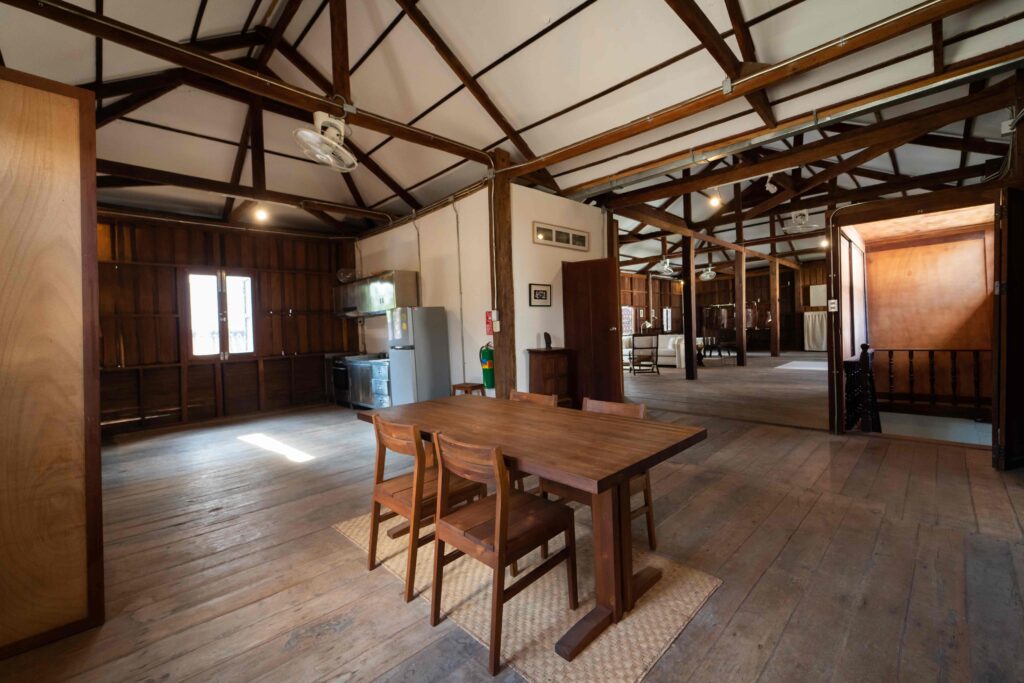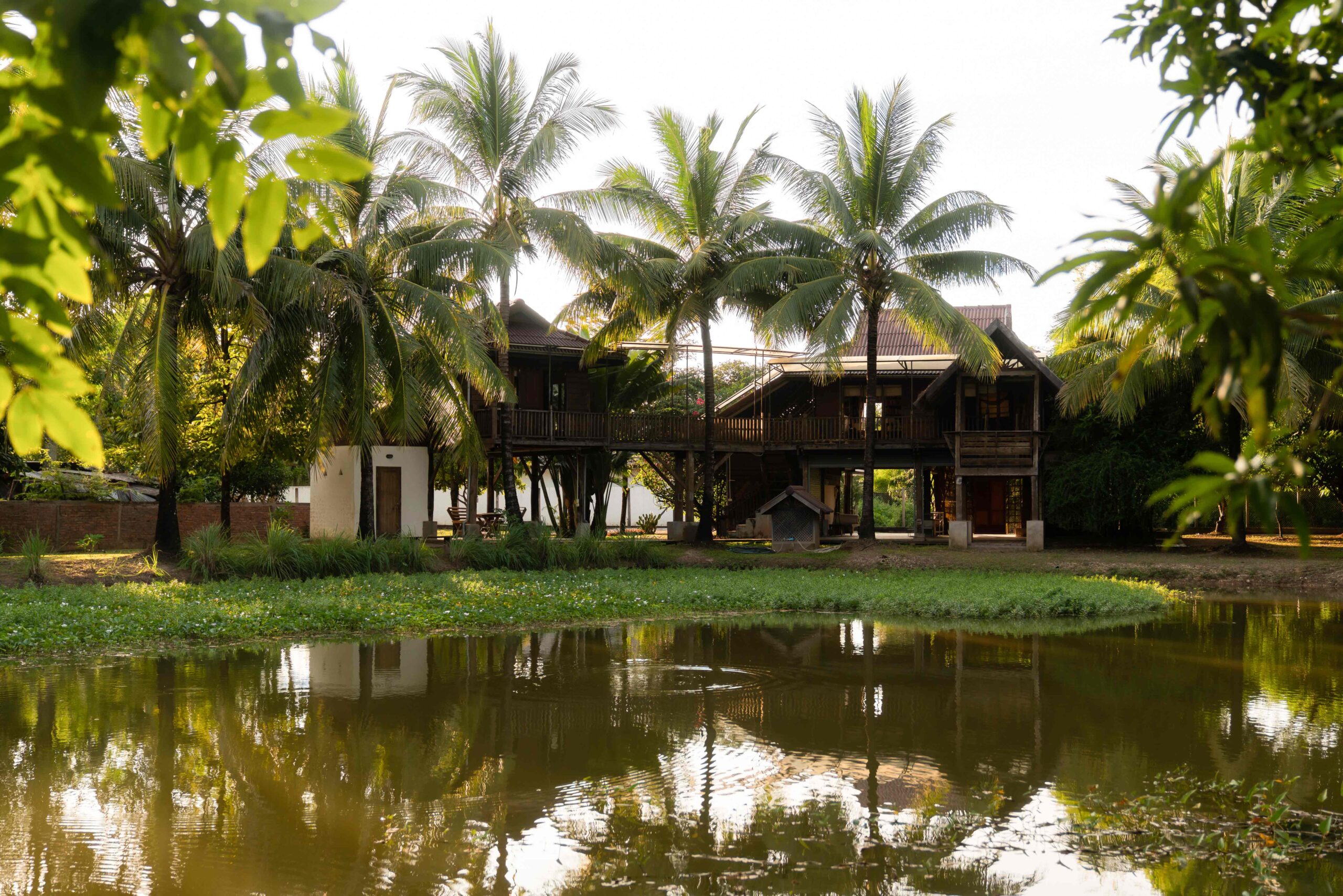Thinking inside, and outside the box, in the little world of Vientiane, over six years, Lanjan’s team of Lao young professionals and Lao contractors transformed four buildings into residential, commercial, and agricultural assets. Under the parasol of Lanna architecture, the wooden structures depict Tai and Dong charms.
During his travels in Laos in 2013, Sri Lankan-born Lao resident, Jeetendra Marcelline discovered wooden structures built by anonymous craftspeople, and architecture without architects. He was enthralled by the tradition, ingenuity, and splendor of indigenous construction created with strange tools.
Founded in 2017, Lanjan Holdings is involved in property development and strives to create modern urban habitats for living and working. The term “Lanjan” is from Kempfer’s Universal History, where the kingdom of Lanjan, “the Land of a Million Elephants,” is mentioned.
Architecture provides shelter, habitat, and envisages a social space, reflecting the vision of the creators and inhabitants. “When we present our architecture to the world, we hold a mirror to our past, present, and future. Travelers will better understand Laos and respect the wisdom underpinning pre-colonial construction techniques”, shares Souksamlan “Toun” Laladeth, Project and Media Executive.
The written history of Lanna, the Land of a Million Rice Fields, dates back over six hundred years. From dynastic succession recorded in chronicles, Lanna was a group of principalities, with vague boundaries through landlocked mountainous territory, hemmed between Chiang Rung to the north, Tak and the Sukothai kingdoms to the south, the Salween River to the west, and the Mekong to the east.
The traditional architecture of Lanna reflected Buddhist beliefs and provided for the worship of ancestral spirits, nature, and other holy items. In the beginning, Lanna architecture was influenced by its neighbors, and from the 16th to 18th centuries western styles, via Britain and Burma, and Chinese elements of construction were introduced.

Famous Lao King Setthathirath ruled Lanna from 1546-51, during which time cultural relations blossomed with its neighbors and Lanna architectural styles flourished in Laos. He established Vientiane as the capital in 1563 and built many iconic structures within what is now known as Vientiane’s Historic Town Conservation Zone. The Zone, near the inner-city wall, inside which the evolution of Vientiane began around 1,000 AD, is of immense historical importance.
During the wars with feudal Siam, in 1827, many of the structures were burned down. After French rule commenced in 1893, many buildings and temples were restored and colonial architecture took root, with some traditional buildings incorporating colonial styles. From there evolved Vientiane’s distinct urban landscape, a microcosm of the most influential styles and social movements, such as Art Nouveau and Bauhaus.
Lao architecture also exchanges inspiration with other Tai people in the region. The Tai are from several areas of Yunnan, scattered along China’s southwest border. The Dong people, who are also part of the larger Tai family, are found in southwest China, inhabiting a rugged mountainous region. Tai and Dong architectural techniques are influenced by the physical and social environment of their communities, and by their agricultural and forestry practices.
Traditional Lao architecture has a unique and rich legacy, due to its culture, social standards, lifestyle, sense of community, belief, and Buddhist religion. The architecture bears witness to a deep social and environmental contract. “Thoughtful arrangement of space and design during modernization allows us to embrace a contemporary lifestyle while preserving the essence of the traditional structure,” says Tae Thaichouathor, Operations Executive.
The traditional Lao “stilt house” tells of how previous generations considered the hot and humid climate, reducing the temperature and humidity by creating living places and a lifestyle that matched their surroundings. Raised houses mitigate flood damage. Airflow is optimized by open central aisles. The area beneath the house is used for storage, lounging during the hotter days, and livestock in pens, and for looms.
Heun Lanna is a traditional Lanna-style stilted home, built by wealthy inhabitants, where the rooms are connected via walkways and bridges. Highly valued wood such as teak, sandalwood, or mahogany are used.

Toupna depicts the mythical Tai bamboo “stilt house”, described in an ancient folktale involving a lord and a golden phoenix. Built with bamboo from the forest and straw from the fields, the fabled house conveys tranquility and harmony with nature.
Sandalwood is Dong style, containing typical features such as vaulted ceilings, a single roof with separations beneath, and stairways inside leading onto a central corridor. The levels are visibly different, the downstairs is constructed with brick or cement, and the upstairs is constructed with wood only.
Hor Tamhuk is also a “stilt house” akin to the Tai “long house” spatial arrangement. It is built with finely carved wood high off the ground and hardwood stilts embedded either into the ground or on stones.
Design and restoration is carried out by Lanjan’s team who believe as Vanpheng Phetsalath, Designer, shares, “Heritage buildings are part of the city’s memory and a nation’s character.” The team has studied architecture and design in Laos and abroad. “We have learned a great deal on the job and apply this knowledge in our own home construction,” says Thongxiong Norpor, Administration Executive, who lived at Sandalwood before the restoration.
All spaces are multi-purpose and materials are chosen with careful consideration of authenticity and climate. For example, centuries-old wood, polished with beeswax and lime plaster, was used on walls. Modern materials and technology are utilized to achieve the highest standards and increase energy efficiency. Nature is sacrosanct, with all flora and fauna protected throughout.
Lanjan has demonstrated that preservation via modernization is possible in Laos with Lao skills. To encourage greater protection of Laos’ architectural heritage, Jeetendra advocates policy measures such as access to long-term concessional finance for restoration of tangible and intangible heritage, as well as exemption from construction-related taxes. At a time of rapid change, Lanjan hopes that its efforts will inspire others and conserve Vientiane’s unique beauty and future as a sustainable ASEAN city and hub.
The properties are not open to the public as yet. For more information on renting or viewing by appointment, visit www.lanjanholdings.com
Text BY Jeetendra Marcelline
PHOTOGRAPHS BY Phoonsab Thevongsa / Souksamlan Laladeth



 ລາວ
ລາວ
